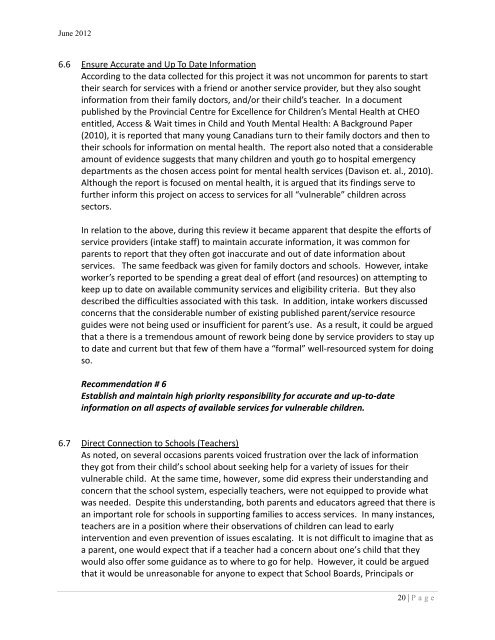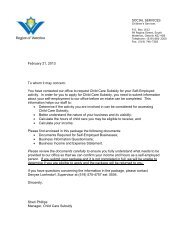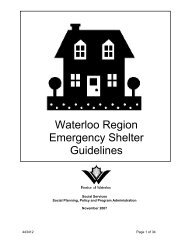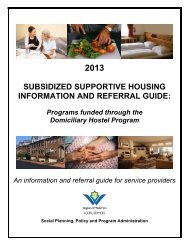Waterloo Children & Youth Services Planning ... - Social Services
Waterloo Children & Youth Services Planning ... - Social Services
Waterloo Children & Youth Services Planning ... - Social Services
Create successful ePaper yourself
Turn your PDF publications into a flip-book with our unique Google optimized e-Paper software.
June 2012<br />
6.6 Ensure Accurate and Up To Date Information<br />
According to the data collected for this project it was not uncommon for parents to start<br />
their search for services with a friend or another service provider, but they also sought<br />
information from their family doctors, and/or their child’s teacher. In a document<br />
published by the Provincial Centre for Excellence for <strong>Children</strong>’s Mental Health at CHEO<br />
entitled, Access & Wait times in Child and <strong>Youth</strong> Mental Health: A Background Paper<br />
(2010), it is reported that many young Canadians turn to their family doctors and then to<br />
their schools for information on mental health. The report also noted that a considerable<br />
amount of evidence suggests that many children and youth go to hospital emergency<br />
departments as the chosen access point for mental health services (Davison et. al., 2010).<br />
Although the report is focused on mental health, it is argued that its findings serve to<br />
further inform this project on access to services for all “vulnerable” children across<br />
sectors.<br />
In relation to the above, during this review it became apparent that despite the efforts of<br />
service providers (intake staff) to maintain accurate information, it was common for<br />
parents to report that they often got inaccurate and out of date information about<br />
services. The same feedback was given for family doctors and schools. However, intake<br />
worker’s reported to be spending a great deal of effort (and resources) on attempting to<br />
keep up to date on available community services and eligibility criteria. But they also<br />
described the difficulties associated with this task. In addition, intake workers discussed<br />
concerns that the considerable number of existing published parent/service resource<br />
guides were not being used or insufficient for parent’s use. As a result, it could be argued<br />
that a there is a tremendous amount of rework being done by service providers to stay up<br />
to date and current but that few of them have a “formal” well-resourced system for doing<br />
so.<br />
Recommendation # 6<br />
Establish and maintain high priority responsibility for accurate and up-to-date<br />
information on all aspects of available services for vulnerable children.<br />
6.7 Direct Connection to Schools (Teachers)<br />
As noted, on several occasions parents voiced frustration over the lack of information<br />
they got from their child’s school about seeking help for a variety of issues for their<br />
vulnerable child. At the same time, however, some did express their understanding and<br />
concern that the school system, especially teachers, were not equipped to provide what<br />
was needed. Despite this understanding, both parents and educators agreed that there is<br />
an important role for schools in supporting families to access services. In many instances,<br />
teachers are in a position where their observations of children can lead to early<br />
intervention and even prevention of issues escalating. It is not difficult to imagine that as<br />
a parent, one would expect that if a teacher had a concern about one’s child that they<br />
would also offer some guidance as to where to go for help. However, it could be argued<br />
that it would be unreasonable for anyone to expect that School Boards, Principals or<br />
20 | P a g e
















